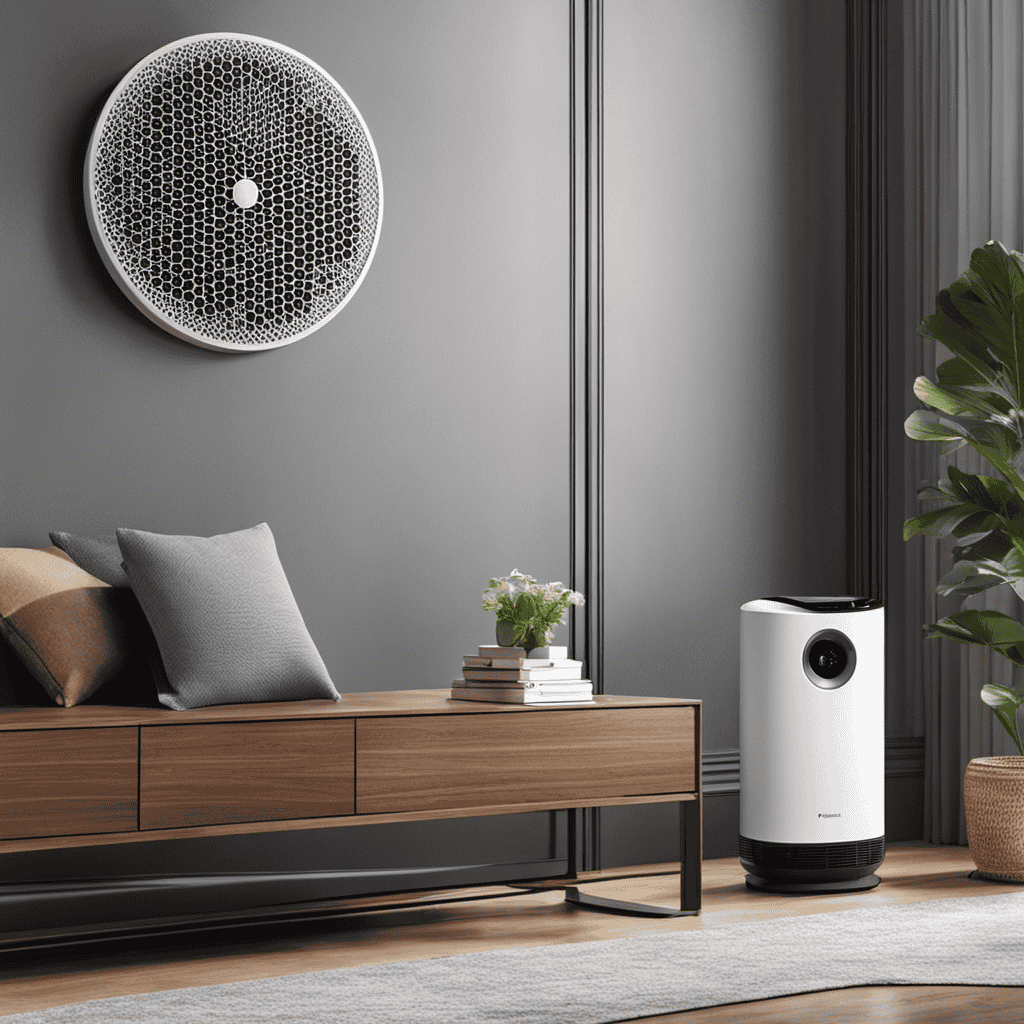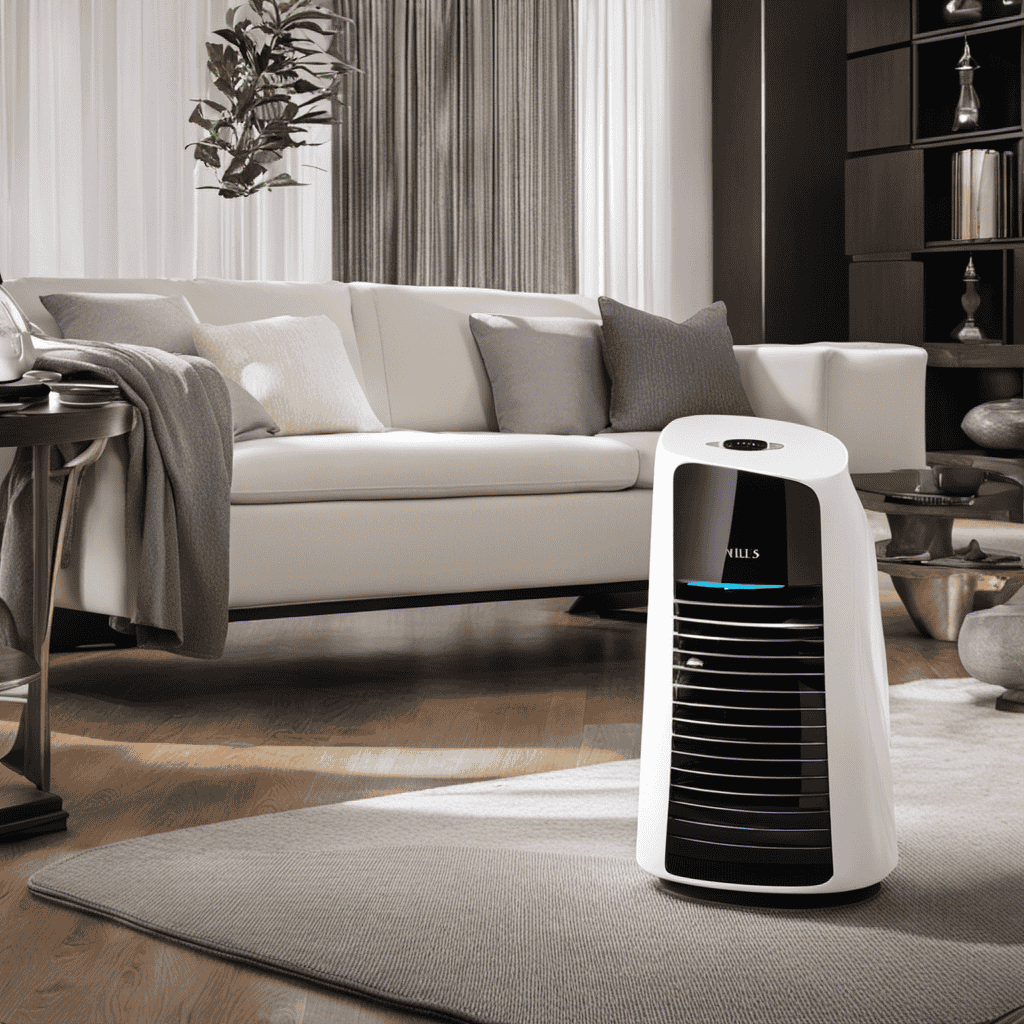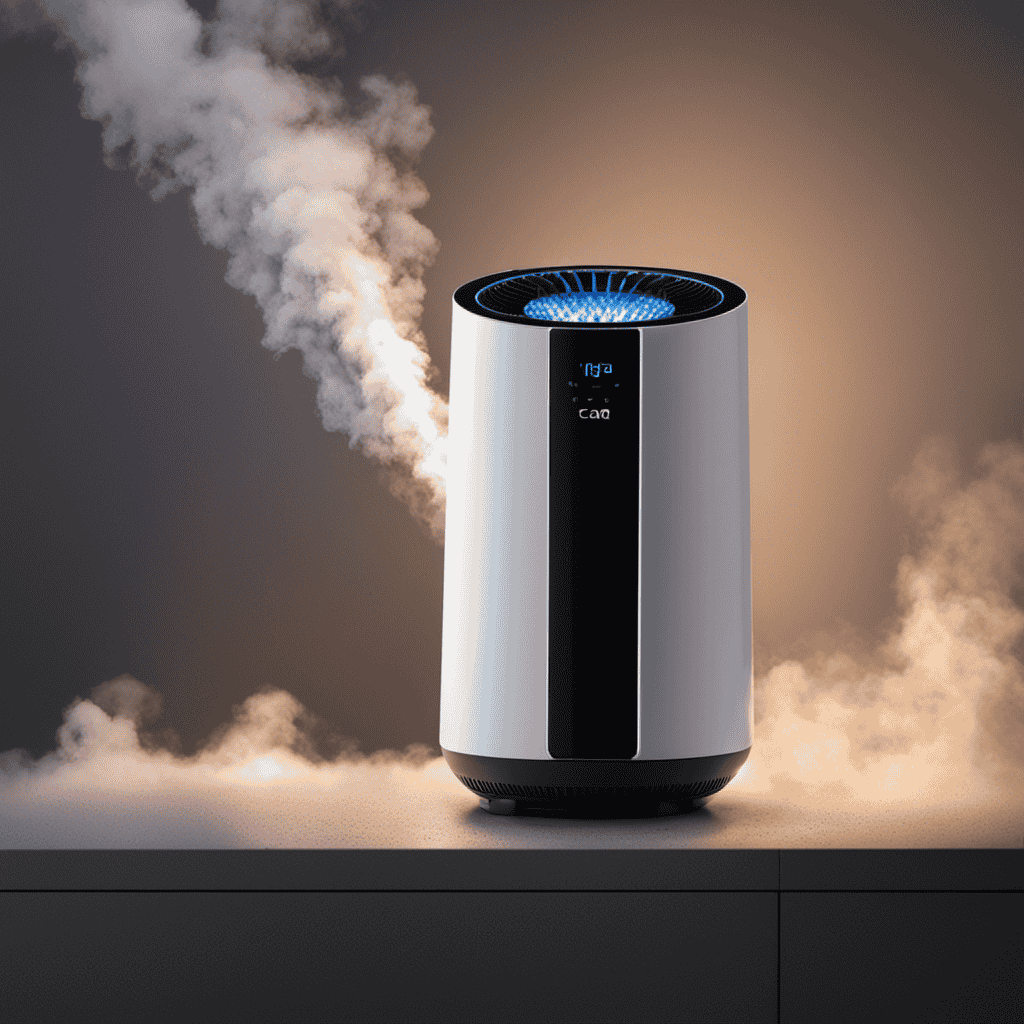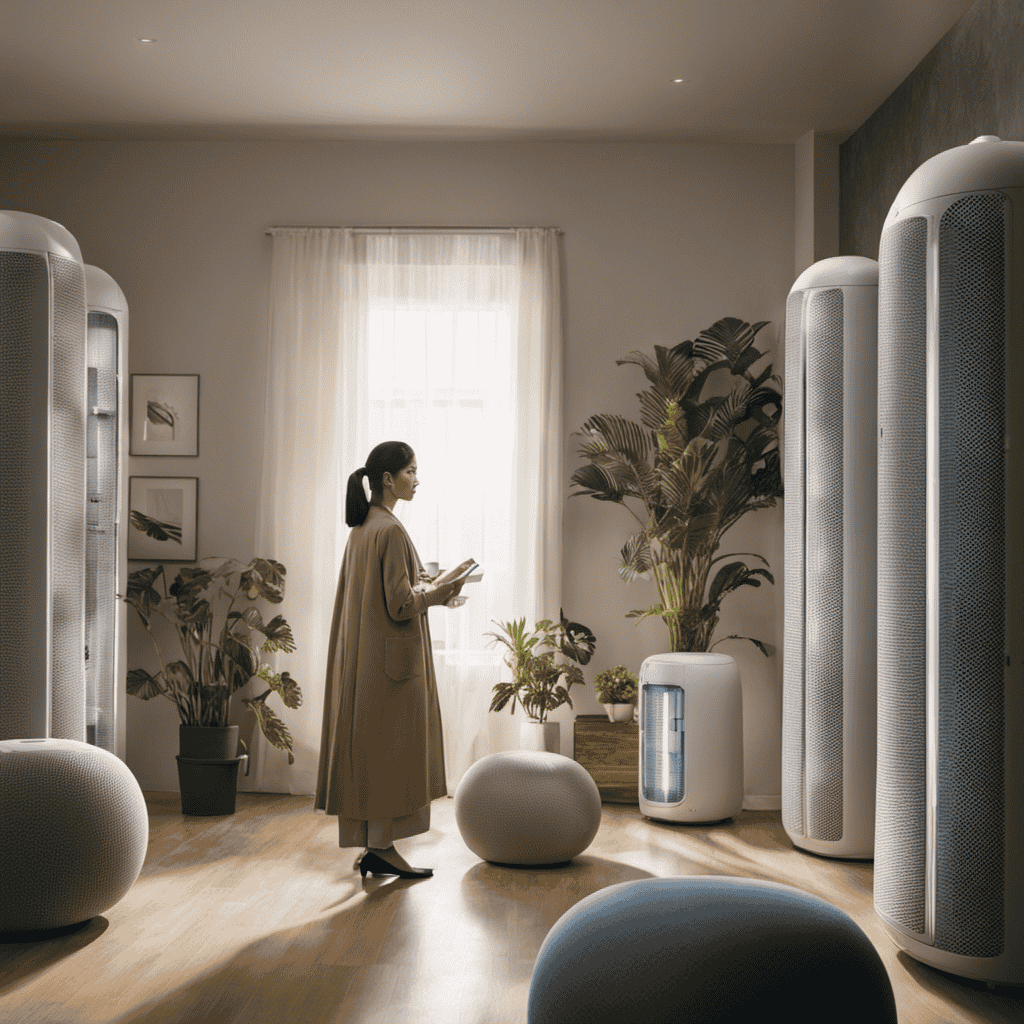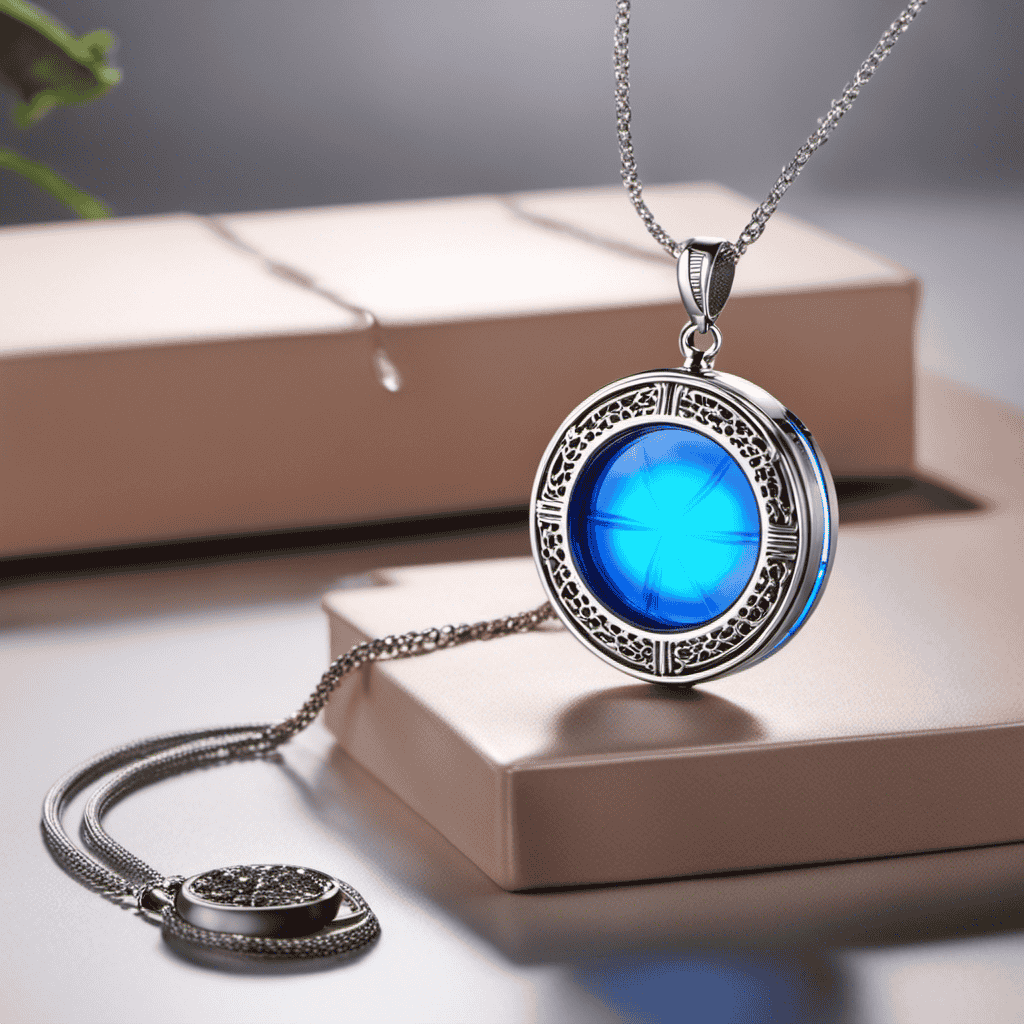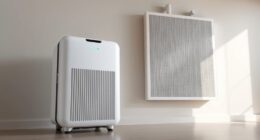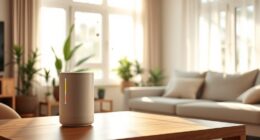Hey there, folks! Ever wondered how you could create your very own air purifier? Well, you’re in luck because I’ve got all the know-how you need to get started.
In this article, I’ll guide you through the step-by-step process of building an air purifier that’ll help you breathe cleaner, fresher air.
We’ll cover everything from gathering the necessary materials to exploring advanced filtration options.
So grab your tools and let’s dive right into the fascinating world of DIY air purification!
Key Takeaways
- Understand different air purification techniques: HEPA filtration, activated carbon adsorption, UV-C light sterilization
- Choose materials based on desired purification method (e.g., HEPA filter for allergens, activated carbon for odors)
- Proper fan placement for optimal air circulation and efficiency
- Regularly replace filters, clean the unit, and ensure proper airflow
Gathering the Necessary Materials
Start by making sure you have all the materials you’ll need for the air purifier. Understanding air purification techniques is crucial in choosing the right materials.
When it comes to air purification, there are various techniques available, such as HEPA filtration, activated carbon adsorption, and UV-C light sterilization. Each technique targets specific pollutants, so it’s important to select materials that align with your desired purification method.
For instance, if you want to remove airborne allergens and particles, a HEPA filter would be essential. Additionally, activated carbon filters are effective at eliminating odors and chemicals. Lastly, UV-C light can be used to kill bacteria and viruses.
By gathering the appropriate materials based on your desired air purification technique, you can ensure an effective and efficient air purifier.
Transitioning into the next section, let’s now delve into understanding the basic principles of air purification.
Understanding the Basic Principles of Air Purification
To understand how an air purifier works, you’ll need to grasp the basic principles behind its operation. Here are the key points to consider:
-
Filtration: Air purifiers use filters to trap and remove airborne particles such as dust, pollen, and pet dander. These filters capture the pollutants, preventing them from circulating in the air you breathe.
-
Activated Carbon: Many air purifiers also incorporate activated carbon filters. These filters are effective at removing odors, gases, and volatile organic compounds (VOCs) from the air.
-
Ionization: Some air purifiers use ionization technology to charge particles in the air. These charged particles then stick to surfaces, making them easier to remove through cleaning or vacuuming.
-
Maintenance: Regular maintenance is crucial for optimal performance. This includes replacing filters as recommended by the manufacturer, cleaning the unit, and ensuring proper airflow.
Understanding these principles will help you make informed decisions when it comes to choosing and maintaining an air purifier for cleaner and healthier indoor air.
Building the Main Frame of the Air Purifier
The first step in building the main frame of an air purifier is attaching the panels together using screws. This ensures a sturdy and secure structure for the air purifier.
Once the panels are securely fastened, the next important aspect to consider is fan maintenance. The fan is a vital component of the air purifier as it circulates the air and helps in the filtration process. Regular cleaning and maintenance of the fan is necessary to ensure optimal performance and longevity of the air purifier.
Additionally, noise reduction techniques can be employed to make the air purifier quieter during operation. This can be achieved by using noise-dampening materials or designing the airflow path in a way that minimizes turbulence and vibration.
Installing the Fan and Filter System
When it comes to installing the fan and filter system in an air purifier, there are several important factors to consider.
First, fan placement is crucial for optimal air circulation and efficiency. I will provide some useful tips on how to position the fan correctly to ensure maximum performance.
Secondly, choosing the right filter type is essential for effectively removing pollutants from the air. I will compare different filter options and discuss their pros and cons.
Lastly, implementing proper air circulation strategies is vital to ensure that clean air is evenly distributed throughout the room. I will share some strategies to achieve efficient air circulation in an air purifier.
Fan Placement Tips
Proper fan placement is essential for optimal air circulation in your homemade air purifier. To ensure efficient airflow optimization and noise reduction, consider these tips:
-
Position the fan at the back of the air purifier to pull air through the filters. This allows for better filtration and helps prevent contaminants from bypassing the filters.
-
Place the fan near the top of the air purifier to promote upward airflow. This helps distribute purified air evenly throughout the room.
-
Avoid placing the fan too close to walls or objects that could obstruct the airflow. Give it enough space to operate smoothly and effectively.
-
Use noise reduction techniques such as foam padding or rubber grommets to minimize vibrations and noise generated by the fan.
By following these guidelines, you can optimize air circulation and reduce noise in your homemade air purifier.
Now, let’s explore the different types of filters and compare their effectiveness.
Filter Types Comparison
Now, let’s take a look at how different filter types compare in terms of effectiveness.
When it comes to air purification, two popular filter types are HEPA and activated carbon filters.
HEPA filters are highly efficient in removing particles as small as 0.3 microns, capturing allergens, dust, and pet dander effectively.
On the other hand, activated carbon filters excel at absorbing odors, chemicals, and volatile organic compounds (VOCs). They work by trapping these pollutants within their porous structure.
While HEPA filters are excellent for improving overall air quality, activated carbon filters are more targeted towards odor and chemical removal. It’s important to note that HEPA filters do not remove gases and odors as effectively as activated carbon filters.
Ultimately, the choice between HEPA and activated carbon filters depends on your specific air purification needs.
Air Circulation Strategies
One effective way to improve air circulation in a room is by using a fan. Fans help to move the air around, creating a more comfortable and breathable environment.
Here are four strategies to optimize airflow and promote better air circulation:
-
Position the fan strategically: Place the fan near a window to draw in fresh air from outside. This will help to improve ventilation and introduce cleaner air into the room.
-
Use oscillating fans: Oscillating fans can move air in multiple directions, distributing it evenly throughout the room. This helps to prevent stagnant air pockets and keeps the airflow consistent.
-
Ceiling fans: Installing a ceiling fan can help to circulate air throughout the entire room. These fans are particularly effective in larger spaces, ensuring that air reaches all corners.
-
Combine with air purification techniques: Pairing a fan with air purification techniques, such as using HEPA filters or activated carbon filters, can further enhance the quality of the air in the room by removing allergens, pollutants, and odors.
Wiring the Power Supply for the Air Purifier
To wire the power supply for your air purifier, you’ll need to connect the positive and negative terminals correctly. Ensuring power supply safety is crucial in any electrical wiring project, and the same applies to your air purifier. Following proper electrical wiring techniques will not only prevent accidents but also ensure optimal performance of your device. Here’s a table summarizing the basic steps to wire your air purifier’s power supply:
| Step | Procedure |
|---|---|
| 1 | Turn off the main power source |
| 2 | Identify the positive and negative terminals |
| 3 | Connect the positive terminal to the positive wire |
| 4 | Connect the negative terminal to the negative wire |
| 5 | Double-check the connections for any loose wires |
| 6 | Turn on the main power source and test the air purifier |
Now that the power supply is properly wired, let’s move on to adding additional features for improved air quality.
Adding Additional Features for Improved Air Quality
To enhance the quality of the air in your space, you can consider incorporating additional features into your device. Here are four features that can help improve the air quality in your environment:
-
Air Quality Sensors: These sensors can detect pollutants and allergens in the air, allowing your air purifier to automatically adjust its settings to maintain clean air.
-
UV-C Light: This feature utilizes ultraviolet light to kill bacteria, viruses, and mold spores, further improving the air quality in your space.
-
Ionizer: An ionizer releases negatively charged ions into the air, which attach to airborne particles and make them heavier, causing them to fall to the ground and be removed from the air you breathe.
-
Essential Oil Diffuser: Some air purifiers come with an essential oil diffuser feature, which not only cleans the air but also adds a pleasant fragrance to your space.
By incorporating these additional features, your air purifier can provide cleaner and fresher air for you and your loved ones.
Now, let’s move on to testing the functionality of the air purifier.
Testing the Functionality of the Air Purifier
In order to ensure the functionality of the air purifier and determine its effectiveness in improving air quality, rigorous testing methods and effectiveness analysis are crucial. Various testing methods can be employed to evaluate the performance of the air purifier, including particle count measurements, air quality index analysis, and airflow velocity measurements. These tests help assess the purifier’s ability to remove pollutants, such as dust, pollen, and smoke, from the air. Additionally, effectiveness analysis can be conducted by comparing the air quality before and after using the air purifier. This analysis provides valuable insights into the purifier’s ability to reduce allergens and improve overall air quality. By employing these testing methods and effectiveness analysis, we can ensure that the air purifier meets its intended purpose of providing clean and healthy air.
| Testing Methods | Effectiveness Analysis |
|---|---|
| Particle count | Before and after air quality comparison |
| Air quality index | Allergen reduction analysis |
| Airflow velocity | Pollutant removal efficiency evaluation |
Securing the Components and Ensuring Proper Ventilation
Securing the components and ensuring proper ventilation is essential for the air purifier to function effectively and provide clean air. To achieve this, follow these steps:
-
Mounting the components: Make sure all the components, such as the fan, filter, and control panel, are securely attached to the air purifier housing. This prevents any loose connections that could affect performance.
-
Sealing air leaks: Check for any gaps or leaks in the housing and seal them properly. This prevents unfiltered air from bypassing the purification process.
-
Optimizing airflow: Position the air purifier in a way that allows for maximum air circulation. Avoid placing it in corners or against walls that could obstruct the airflow.
-
Implementing noise reduction techniques: Noise can be a concern with air purifiers. Consider using noise-absorbing materials or placing the purifier in a less noisy area to minimize any disturbances.
Troubleshooting Common Issues With DIY Air Purifiers
One common issue with DIY air purifiers is that they may not effectively filter out all pollutants. Troubleshooting filter issues is crucial to ensure that the air purifier is working efficiently. One potential problem could be a clogged filter, which can hinder the airflow and limit the purifier’s ability to capture pollutants. Regularly cleaning or replacing the filter can help resolve this issue.
Another issue that DIY air purifiers may face is excessive noise. Addressing noise problems can be done by checking for loose parts or improper installation of the fan or motor. Additionally, placing the air purifier on a stable surface and ensuring proper ventilation can help reduce noise levels.
Maintaining and Cleaning the Air Purifier Regularly
Regularly cleaning and maintaining the DIY air purifier is essential for optimal performance and improved air quality. Here are some cleaning techniques and a maintenance schedule to ensure the longevity of your air purifier:
-
Replace or clean the filters: The filters trap dust, allergens, and pollutants, so they need to be cleaned or replaced regularly to maintain efficiency.
-
Vacuum the exterior: Dust and debris can accumulate on the exterior of the purifier, affecting its performance. Use a vacuum cleaner with a brush attachment to remove any dirt.
-
Wipe down the control panel: Use a damp cloth to clean the control panel and remove any fingerprints or dirt that may affect the functioning of the purifier.
-
Check the fan and vents: Dust can build up on the fan and vents, obstructing airflow. Use a soft brush or compressed air to clean these areas.
Following a regular maintenance schedule will ensure that your DIY air purifier continues to function effectively and keeps the air in your home clean and fresh.
Enhancing the Aesthetics of the Air Purifier
Now that we have covered the importance of regular maintenance and cleaning for optimal performance of your air purifier, let’s explore how you can enhance its aesthetics.
The design of an air purifier can play a significant role in blending it seamlessly with your home decor. To find inspiration for the design, you can look at various sources such as interior design magazines, online platforms, or even nature itself. Once you have gathered some ideas, you can consider DIY air purifier customization. This can involve painting the exterior casing, adding decorative elements, or even creating a custom cover.
By personalizing the look of your air purifier, you can ensure that it not only cleans the air but also adds to the overall ambiance of your living space.
Transitioning to the next section, let’s now delve into exploring advanced filtration options for the air purifier.
Exploring Advanced Filtration Options for the Air Purifier
To enhance the performance of your air purifier, you can explore advanced filtration options that are available in the market. These advanced filtration techniques utilize innovative air purification methods to ensure cleaner and healthier air in your home.
Here are four options to consider:
-
High-Efficiency Particulate Air (HEPA) Filters: These filters are designed to capture particles as small as 0.3 microns, including pollen, dust mites, and pet dander.
-
Activated Carbon Filters: These filters are effective in removing odors, gases, and volatile organic compounds (VOCs) from the air.
-
Ultraviolet Germicidal Irradiation (UVGI): This method uses UV light to kill bacteria, viruses, and other microorganisms present in the air.
-
Photocatalytic Oxidation (PCO): This filtration technique combines UV light with a catalyst to break down harmful pollutants into harmless byproducts.
By incorporating these advanced filtration options, you can significantly improve the air quality in your home.
However, for even more convenience and efficiency, consider incorporating smart technology into your DIY air purifier.
Incorporating Smart Technology Into Your DIY Air Purifier
When it comes to improving air quality, incorporating smart technology into DIY air purifiers can offer numerous benefits.
Smart tech allows for real-time monitoring and control of air quality, ensuring that the purifier is always operating at its optimal level.
Additionally, DIY air purifiers can be upgraded with smart features such as automated scheduling and remote control, making it easier than ever to maintain a clean and healthy environment.
Benefits of Smart Tech
Using smart technology in an air purifier has several benefits. As a user, I have experienced these advantages firsthand.
-
Smart home integration: With smart technology, my air purifier seamlessly connects to my smart home system, allowing me to control and monitor the air quality from anywhere using my smartphone or voice assistants like Alexa or Google Home.
-
Energy efficiency: Smart air purifiers are designed to be energy-efficient, automatically adjusting their settings based on the air quality and occupancy of the room. This not only saves energy but also reduces electricity costs.
-
Real-time monitoring: Smart air purifiers provide real-time data about the indoor air quality, including pollutants, temperature, and humidity levels. This information helps me make informed decisions about when to turn on the purifier and how to improve the air quality.
-
Smart scheduling: I can set custom schedules for my air purifier to operate at specific times of the day, ensuring clean air when I need it the most, such as during sleep or when I’m away from home.
Overall, incorporating smart technology into an air purifier enhances convenience, energy efficiency, and the ability to maintain optimal indoor air quality.
DIY Air Purifier Upgrades
Upgrade your existing air filtration system with simple do-it-yourself modifications to improve its performance and effectiveness.
Enhancing the filter efficiency is crucial in achieving cleaner air. One effective way to upgrade is by using a high-efficiency particulate air (HEPA) filter, which can remove up to 99.97% of airborne particles as small as 0.3 microns.
Additionally, consider customizing the fan speed to optimize air circulation. Increasing the fan speed will help improve the filtration process by drawing in more air and increasing the contact time between pollutants and the filter. However, be cautious not to set the fan speed too high as it may strain the motor or create excessive noise.
Automation and Air Quality
In my previous discussion on DIY air purifier upgrades, I highlighted the importance of improving the efficiency of these devices. Now, let’s delve into the realm of automation and its impact on air quality.
With advancements in technology, automation has become a key feature in air purification systems, offering numerous benefits. Here are four reasons why automation is revolutionizing the way we purify our air:
-
Real-time monitoring: Automated air purifiers continuously measure air quality and adjust their settings accordingly, ensuring optimal purification at all times.
-
Smart scheduling: These devices can be programmed to operate based on your daily routine, ensuring clean air when you need it most.
-
Intelligent filtration: Automation allows air purifiers to intelligently detect and target specific pollutants, providing targeted purification for enhanced effectiveness.
-
Remote control: With the ability to connect to your smartphone or other devices, automation allows you to monitor and control your air purifier from anywhere, ensuring clean air even when you’re away.
The impact of air quality on our health cannot be overstated. By incorporating automation into air purification systems, we can improve air quality, leading to better health outcomes for everyone.
Upgrading the Performance of the Air Purifier
To enhance the performance of the air purifier, you can replace the filter. By regularly replacing the filter, you can improve the air purification efficiency and optimize the filter lifespan.
The filter is a crucial component of the air purifier as it traps and removes particles, allergens, and pollutants from the air. Over time, the filter becomes clogged and less effective, which is why it is important to replace it periodically. By doing so, you ensure that the air purifier continues to operate at its highest efficiency, providing you with cleaner and healthier air.
Upgrading the performance of the air purifier through filter replacement is a simple yet effective way to maintain optimal air quality in your home.
Now that you have enhanced the performance of your air purifier, let’s move on to the next step: sharing your homemade air purifier with others.
Sharing Your Homemade Air Purifier With Others
Once you’ve improved the air purifier’s performance, it’s time to share it with others and help them enjoy cleaner air too. Sharing your homemade air purifier can be a rewarding experience, as you can help others improve the air quality in their homes.
Here are some tips for sharing your creation:
-
Share your experiences: Talk about how you made the air purifier and the improvements you made. Share before and after air quality measurements to show the effectiveness of your device.
-
Provide troubleshooting tips: Explain common issues that may arise and how to fix them. This will help others troubleshoot any problems they encounter with their own air purifiers.
-
Offer guidance: Provide step-by-step instructions or a video tutorial on how to build their own air purifier. This will empower others to create their own cleaner air solutions.
-
Encourage feedback: Ask others to share their experiences with your air purifier and provide feedback. This will help you improve your design and troubleshoot any issues that may arise.
Sharing your homemade air purifier can make a positive impact on the lives of others by helping them breathe cleaner air. By sharing your experiences and troubleshooting tips, you can empower others to enjoy the benefits of a homemade air purifier.
Frequently Asked Questions
What Are the Potential Risks of Not Ensuring Proper Ventilation When Building an Air Purifier?
Not ensuring proper ventilation when building an air purifier can pose potential risks. Inadequate ventilation can lead to poor air circulation, which can result in the buildup of pollutants and allergens, compromising indoor air quality and potentially causing health issues.
How Often Should the Filter System Be Replaced in Order to Maintain Optimal Air Purification?
To determine the ideal air filter replacement frequency for optimal air purification, factors such as the level of air pollution, usage time, and filter type must be considered. These factors can affect the lifespan of an air purifier filter.
What Are Some Common Troubleshooting Tips for DIY Air Purifiers That Are Not Functioning Properly?
When DIY air purifiers aren’t functioning properly, there are several common issues that can be troubleshooted. Check for clogged filters, ensure proper airflow, and inspect the power source for any faults.
Are There Any Specific Cleaning Techniques or Products That Should Be Used to Maintain the Air Purifier?
Specific cleaning techniques and recommended products are essential for maintaining an air purifier. Regularly cleaning the filters, wiping down the exterior, and using appropriate cleaning solutions ensure optimal performance and prolong the lifespan of the device.
How Can Smart Technology Be Incorporated Into a DIY Air Purifier, and What Additional Features Does It Provide?
Smart technology integration in a DIY air purifier enhances its functionality and efficiency. Automation allows for real-time monitoring, automatic adjustments, and remote control. These features provide convenience, energy savings, and improved air quality in our living spaces.
Can I Make My Own Air Purifier at Home?
Yes, you can make your own air purifier at home using an air purifier effectively. One simple way is to attach a HEPA filter to a box fan. Another method is to create a DIY air purifier using activated charcoal and a small fan. These homemade options can help improve indoor air quality.
Conclusion
In conclusion, creating your own air purifier can be a rewarding and practical endeavor. By following the steps outlined in this article, you can transform basic materials into a powerful tool for improving air quality.
Just like a skilled scientist in a lab, you have the power to engineer a device that not only cleanses the air but also incorporates advanced filtration options and smart technology.
So, let your creativity soar and share your homemade air purifier with others, as we all strive for cleaner and healthier environments.
